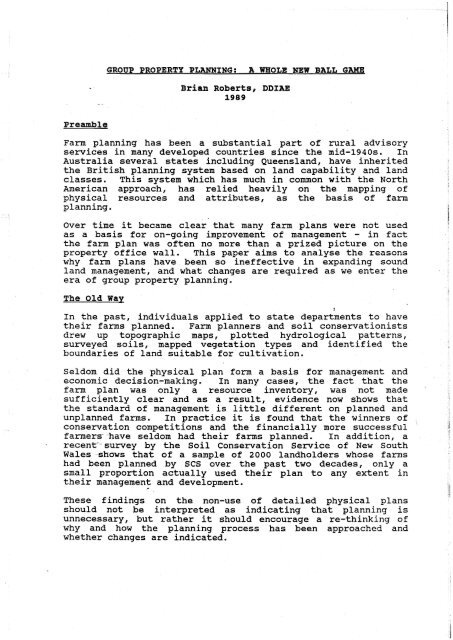soil-conservation-people-religion-and-land.pdf - South West NRM
soil-conservation-people-religion-and-land.pdf - South West NRM
soil-conservation-people-religion-and-land.pdf - South West NRM
You also want an ePaper? Increase the reach of your titles
YUMPU automatically turns print PDFs into web optimized ePapers that Google loves.
Brian Roberts, DDIAE<br />
1989<br />
Farm planning has been a substantial part of rural advisory<br />
services in many developed countries since the mid-1940s. In<br />
Australia several states including Queensl<strong>and</strong>, have inherited<br />
the British planning system based on l<strong>and</strong> capability <strong>and</strong> l<strong>and</strong><br />
classes. This system which has much in common with the North<br />
American approach, has relied heavily on the mapping of<br />
physical resources <strong>and</strong> attributes, as the basis of farm<br />
planning.<br />
Over time it became clear that many farm plans were not used<br />
as a basis for on-going improvement of management - in fact<br />
the farm plan was often no more than a prized picture on the<br />
property office wall. This paper aims to analyse the reasons<br />
why farm plans have been so ineffective in exp<strong>and</strong>ing sound<br />
l<strong>and</strong> management, <strong>and</strong> what changes are required as we enter the<br />
era of group property planning.<br />
The O ld Way<br />
In the past, individuals applied to state departments to have<br />
their farms planned. Farm planners <strong>and</strong> <strong>soil</strong> <strong>conservation</strong>ists<br />
drew up topographic maps, plotted hydrological patterns,<br />
surveyed <strong>soil</strong>s, mapped vegetation types <strong>and</strong> identified the<br />
boundaries of l<strong>and</strong> suitable for cultivation.<br />
Seldom did the physical plan form a basis for management <strong>and</strong><br />
economic decision-making. In many cases, the fact that the<br />
farm plan was only a resource inventory, was not made<br />
sufficiently clear <strong>and</strong> as a result, evidence now shows that<br />
the st<strong>and</strong>ard of management is little different on planned <strong>and</strong><br />
unplanned farms. In practice it is found that the winners of ,<br />
<strong>conservation</strong> competitions <strong>and</strong> the financially more successful<br />
farmers +ave seldom had their farms planned. In addition, a<br />
- recent-survey by the Soil Conservation Service of New <strong>South</strong><br />
Wales -shows that of a sample of 2000 l<strong>and</strong>holders whose farms<br />
had been planned by SCS over the past two decades, only a<br />
small proportion actually used their plan to any extent in<br />
their management <strong>and</strong> development.<br />
C<br />
These findings on the non-use of detailed physical plans<br />
should not be interpreted as indicating that planning is<br />
unnecessary, but rather it should encourage a re-thinking of<br />
why <strong>and</strong> how the planning process has been approached <strong>and</strong><br />
whether changes are indicated.<br />
1
















